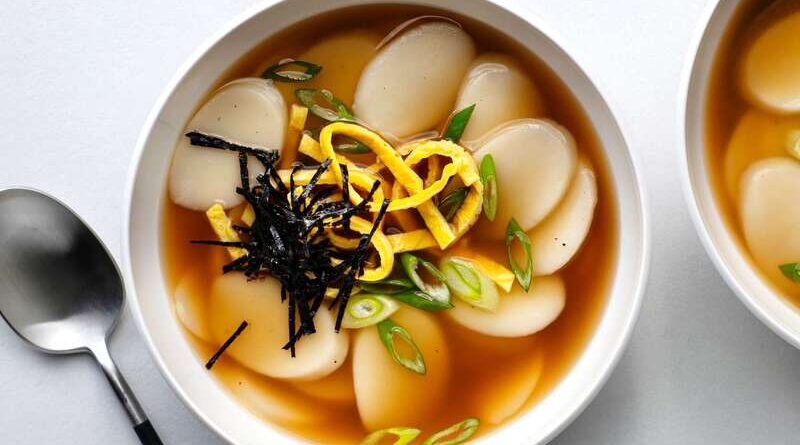Easy Homemade Korean Rice Cake Soup Recipe
Greetings from the flavorful realm of Korean food, where each dish evokes a sense of tale telling and each flavor tantalizes the senses. We explore the comforting nature of Korean rice cake soup in this piece. Learn about the varied cultural interpretations and deep cultural significance of this popular comfort dish. Take a gastronomic trip with us as we explore innovation and the ageless appeal of a hot bowl of rice cake soup.
Korean Rice Cake Soup Ingredients
| Ingredients | Quantity |
|---|---|
| Rice cakes (tteok) | 200 grams |
| Beef or chicken | 200 grams |
| Water | 6 cups |
| Garlic cloves | 3 cloves |
| Ginger | 1-inch piece |
| Green onions | 3 stalks |
| Soy sauce | 2 tablespoons |
| Salt | To taste |
| Sesame oil | 1 tablespoon |
| Thinly sliced beef, pork, or seafood | 150 grams (optional) |
| Vegetables (e.g., Korean radish, carrots, spinach) | As desired (optional) |
| Dumplings | As desired (optional) |
| Eggs | 2 (optional) |
| Toasted sesame seeds | As desired (optional) |
| Thinly sliced green onions | As desired (optional) |
Korean Rice Cake Soup Preparation Methods
Tteokguk, or Korean rice cake soup, is made using a traditional method that values balance, simplicity, and meticulousness. While there are variances based on family recipes and local traditions, several traditional practices are frequently followed.
Preparing the Broth:
Making the tasty broth is the first step in preparing tteokguk. Usually, fragrant vegetables like garlic, ginger, and green onions are cooked with beef or chicken bones for a few hours. Rich and delicious broth is produced as a result of the ingredients’ essence being extracted through slow simmering.
Slicing the Rice Cakes:
The main component of tteokguk, rice cakes, are often cut into thin strips or oval forms. While some homes choose thinner slices for a more delicate mouthfeel, others choose larger slices for a heartier texture. Based on local customs and personal desire, the rice cakes might have different sizes and shapes.
Broth Seasoning:
After the broth is cooked, it’s seasoned to taste using either salt or soy sauce. Carefully adjusting the seasoning is necessary to attain the ideal harmony of flavors. For even more flavor depth, certain recipes may additionally ask for the inclusion of additional ingredients like fish sauce or sesame oil.
Cooking the Rice Cakes:
After adding the sliced rice cakes to the seasoned broth. Simmer them until they are soft but still have a tiny crunch to them. The rice cakes should not be overcooked as this may cause them to get mushy and lose their firmness.
Adding Extra Items:
Other items that can be added to the soup include vegetables, dumplings. And thinly sliced beef or pork, depending on the recipe. Cooking these components through to a delicate consistency is the goal.
Garnishing and Korean Rice Cake Soup Serving:
To add taste and visual appeal, thinly slice green onions and maybe sprinkle toasted sesame seeds on top of the Tteokguk before serving. It is usually served hot and steaming in separate bowls. Ready to be paired with traditional Korean side dishes such as pickled veggies and kimchi.
Customs and Rituals:
Eating Tteokguk is connected with certain customs and rituals in addition to the preparation phase. For instance, it is traditional for Koreans to consume tteokguk during the Lunar New Year celebration as a representation of aging by one year. Soup is typically consumed with loved ones, creating a feeling of rebirth and community.
Korean Rice Cake Soup Health Advantages and Nutritiousness
Tteokguk, or Korean rice cake soup, is tasty and has a lot of health advantages. Because it’s low in calories, it’s a good choice for people who are controlling their weight. Tteokguk also offers an excellent dose of protein, which is necessary for general health and muscle regeneration.
Simmered with flavorful veggies, the broth is high in vitamins and minerals, including potassium and vitamin C, which promote healthy bones and the immune system. Sustained energy is provided by the complex carbs in rice cakes, and gut health may be aided by the probiotic-rich fermented side dishes like kimchi. All in all, Tteokguk is a healthy and reassuring option since it nourishes the body and the psyche.
Korean Rice Cake Soup Serving and Presentation
The skill of serving Tteokguk, or Korean rice cake soup, elevates the eating experience. Tteokguk is traditionally served in shallow bowls to highlight the rice cakes and tasty broth. Every spoonful of food has a harmonious combination of flavors and sensations thanks to careful ingredient placement. The meal gains color and fragrance from garnishes like toasted sesame seeds and finely sliced green onions.
A variety of “banchan,” or side dishes, are typically served with tteokguk to enhance the soup’s flavor. Enjoying Tteokguk is enhanced when the table is beautifully set and the service is warm and welcoming, making it a special meal for both family and guests.
Conclusion
In conclusion, the Korean rice cake soup, or tteokguk, represents more than just a cozy dish; it’s a representation of customs and cultural history. Its careful, well-balanced preparation results in a tasty soup that feeds the body and the soul. Tteokguk, especially during the Lunar New Year celebrations, is a symbol of community, celebration, and rejuvenation because of its rich cultural significance and variety of interpretations.
Beyond its cultural significance, tteokguk is a healthy option for anyone looking for a filling and fulfilling meal because of its many health benefits. Tasted with friends and family on special occasions or as a cozy dinner on any day, Tteokguk takes us on a culinary adventure, honoring creativity while maintaining its timeless charm.
